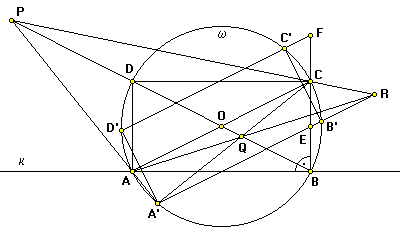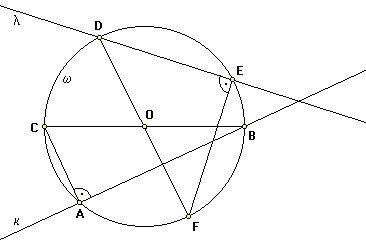Slightly different proof of Steiner's theorem:
(or am I asking for trouble?)Given a circle w with the center O and a line k º AB passing through the circle center, we can draw a parallel l to this line through and arbitrary point D on the circle using the basic straightedge construction #1 (see Drop a normal) with the line seqment AB and its midpoint O. Since the new line l does not pass through the circle center, we can erect a normal to this line at either of its 2 intersection points C, D with the circle w using a straightedge alone. Subsequently, we can shift this normal to any point on the line k º AB using the basic straightedge construction #1 with the line segment DE and its midpoint F.

Given a circle w with the center O and a line k º AB intersecting the circle but not passing through the circle center, we can erect a normal to this line at either point of intersection A or B and complete the rectangle ABCD using a straightedge alone. Then we draw a parallel to the rectangle diagonal AC through an arbitrary point A' on the circle w using the basic straightedge construction #1 with the line seqment AC and its midpoint O. Once we have the parallel A'B', we can complete another rectangle A'B'C'D' using a straightedge alone. Subsequently, we can shift this normal to any point on the line k º AB using the basic straightedge construction #1 with the line segment EF and its midpoint C.

Conversly, given a circle w with an unknown center, if we can erect normals to any 2 lines k, l intersecting the circle at their intersection points with the circle, we can complete the construction of the circle center O with a straightedge alone.

Hence, the ability to erect a normal to a line intersecting the circle with a straightedge alone is equivalent to having the circle center.
Suppose it is possible to erect a normal to a given line with a straightedge alone and without having the center of any circle at our disposal. Since lines project to lines under the parallel projection, any parallel projection of such a construction follows the same rules as the actual construction and must also yield a normal, which is of course absurd. Therefore, it is not possible to find a circle center with a straigtedge alone.